Learn how to make rose lotion bars! This is a lovely lotion bar recipe that uses rose-infused oil and cocoa butter and is soothing for the skin. They are easy to make and a wonderful addition to your homemade bath and beauty products, and perfect for a handmade Valentine’s gift!
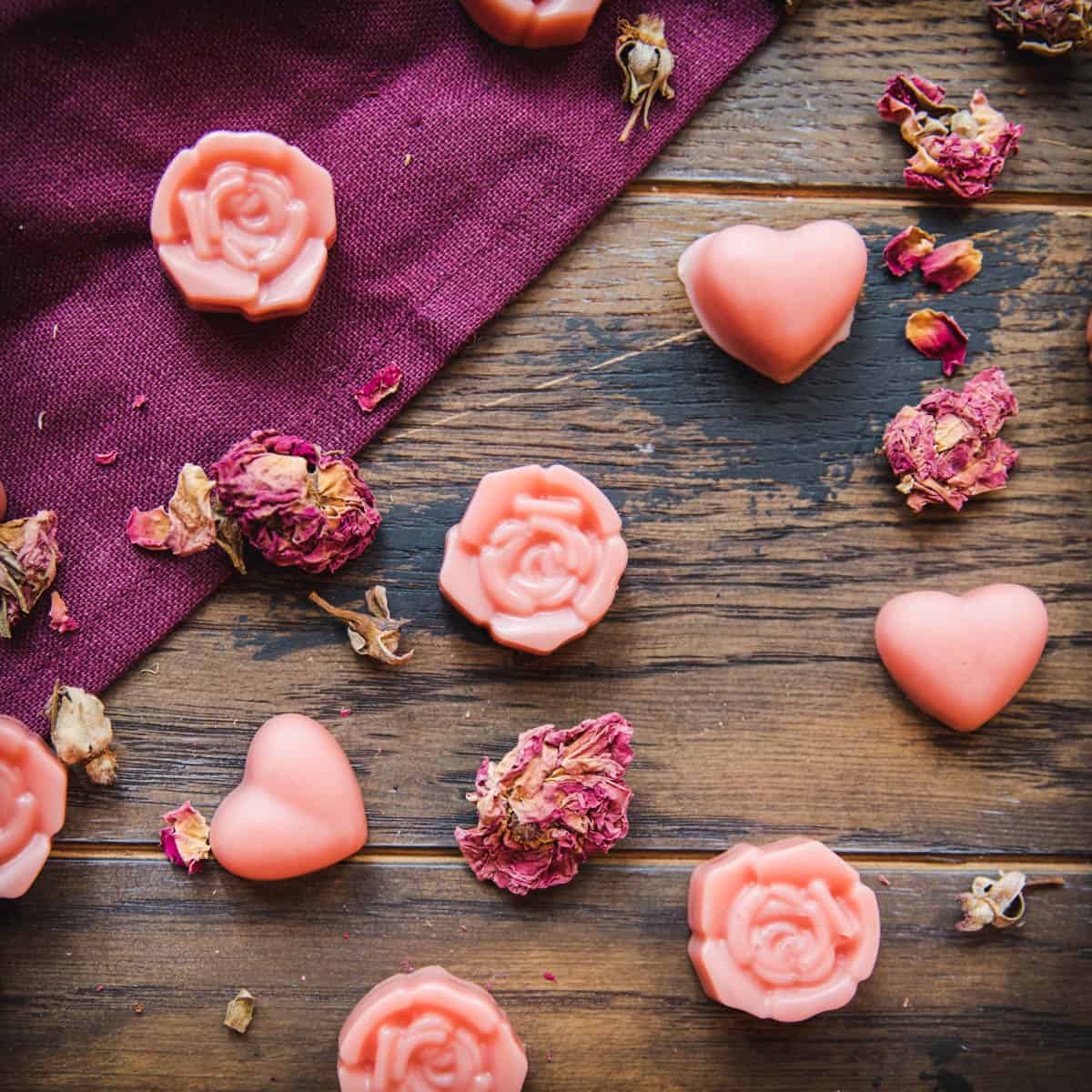
The Big Book of Homemade Products for Your Skin, Health & Home
This recipe is adapted from the Cocoa Rose Lotion Bars in Jan Berry’s (of The Nerdy Farm Wife blog) newly updated and expanded book, The Big Book of Homemade Products for Your Skin, Health & Home.
You might remember Jan from my How to Make Soap for Beginners post, as it was her lovely Natural Soap Making eBook that has been so helpful to me in my soap-making adventure!
This book is amazing and full of wonderful homemade bath, beauty, and health recipes using herbs and flowers!
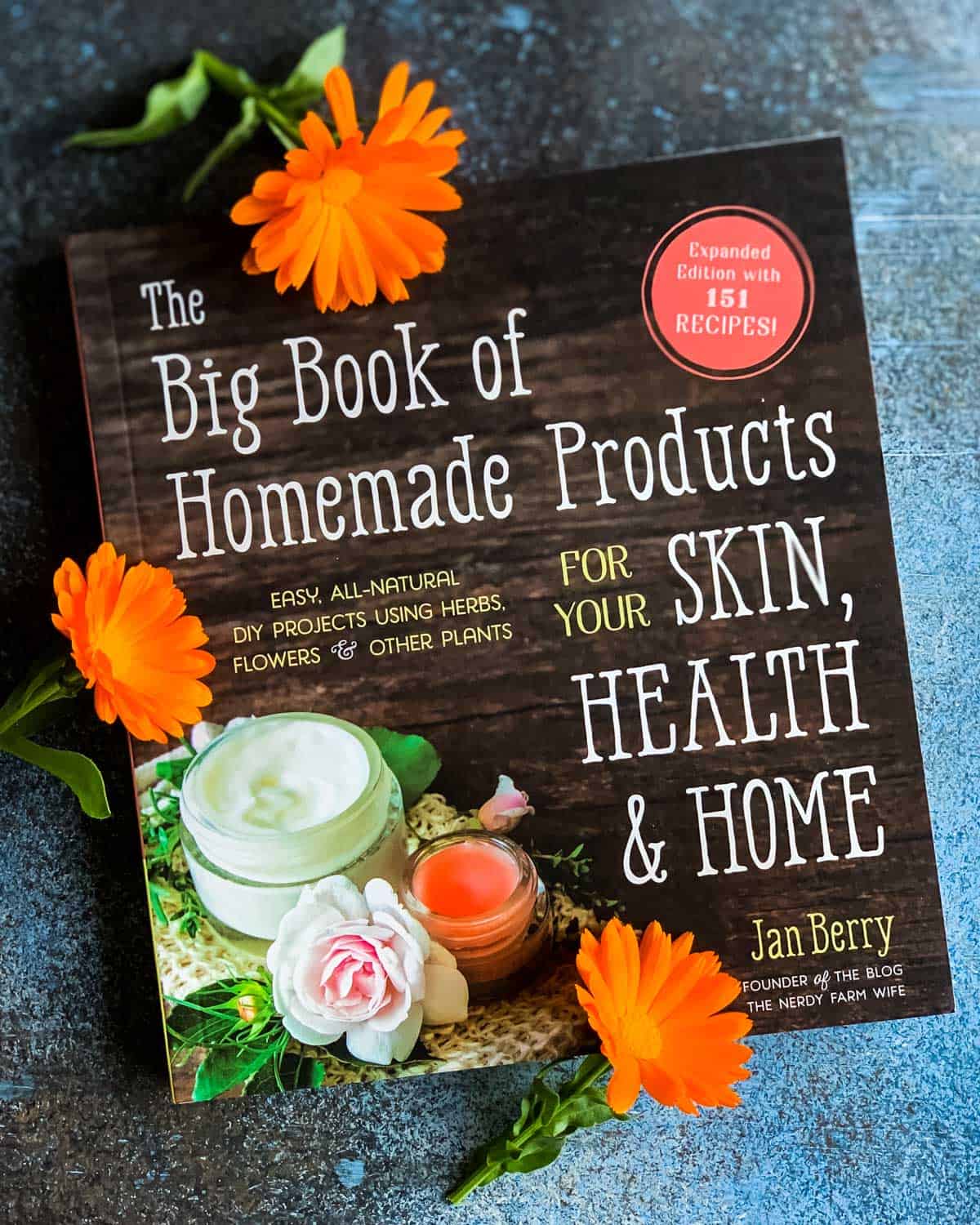
Using Garden or Wild Roses for Skin Care
We have a huge rose bush in the front yard of our house that we just kind of let grow wild.
We haven’t really had the chance to do much to the front of the house yet as we’ve been so focused on getting the backyard where we want it, so I figured having a gigantic unruly rose bush covered in pink flowers wasn’t that much of a bad thing. At least it sort of covers up all of the ugly parts of the yard!
I knew I had to do something with all those roses, though, besides feeding them to my chickens (they go nuts for the petals) and making rose kombucha.
Roses (and rose hips) are excellent for skin care, so making homemade lotion bars was the first thing I thought of. Rose petals are cooling and anti-inflammatory, making them a perfect choice for soothing dry and irritated skin.
If you are interested in making lotion bars but don’t have a huge overgrowth of roses as I do, or just aren’t that into roses, try these dandelion lotion bars, pine lotion bars or super soothing calendula lotion bars.
The first step if you are using fresh roses from your yard is to dry them. I like to use my homemade herb and flower drying screens for this.
You can also use foraged wild roses of course!
If you don’t have either, you can purchase dried rose petals from Mountain Rose Herbs.
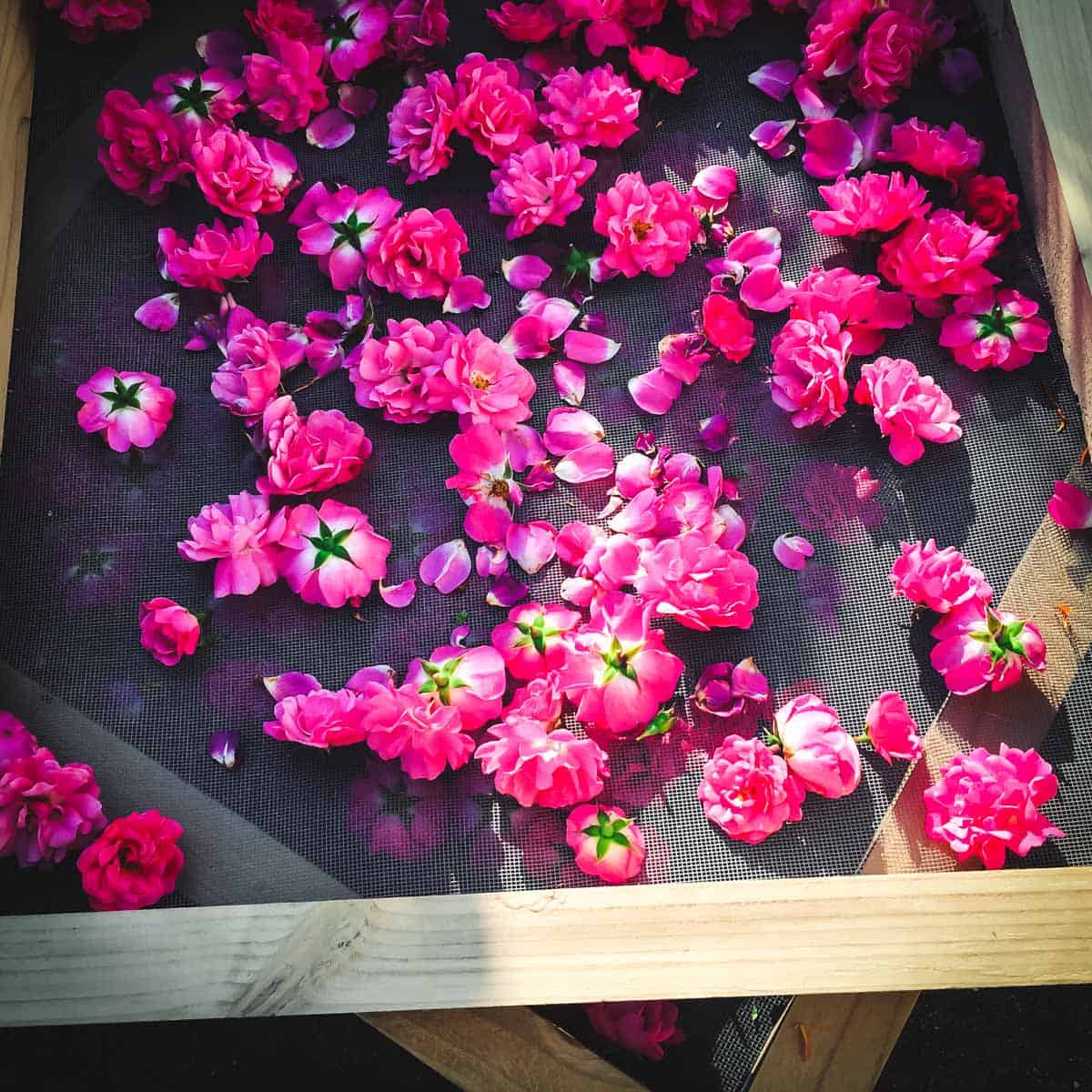
Rose Lotion Bars Ingredients
Infused Oil
Dried rose petals are naturally good for the skin, being cooling and soothing to dry, inflamed, and itchy skin. They are perfect for use in lotion, creams, and lotion bars.
You could easily use other flowers instead of roses as well, such as calendula or lavender. It’s an extremely adaptable recipe!
For today, considering that Valentine’s Day coming up, roses it is!
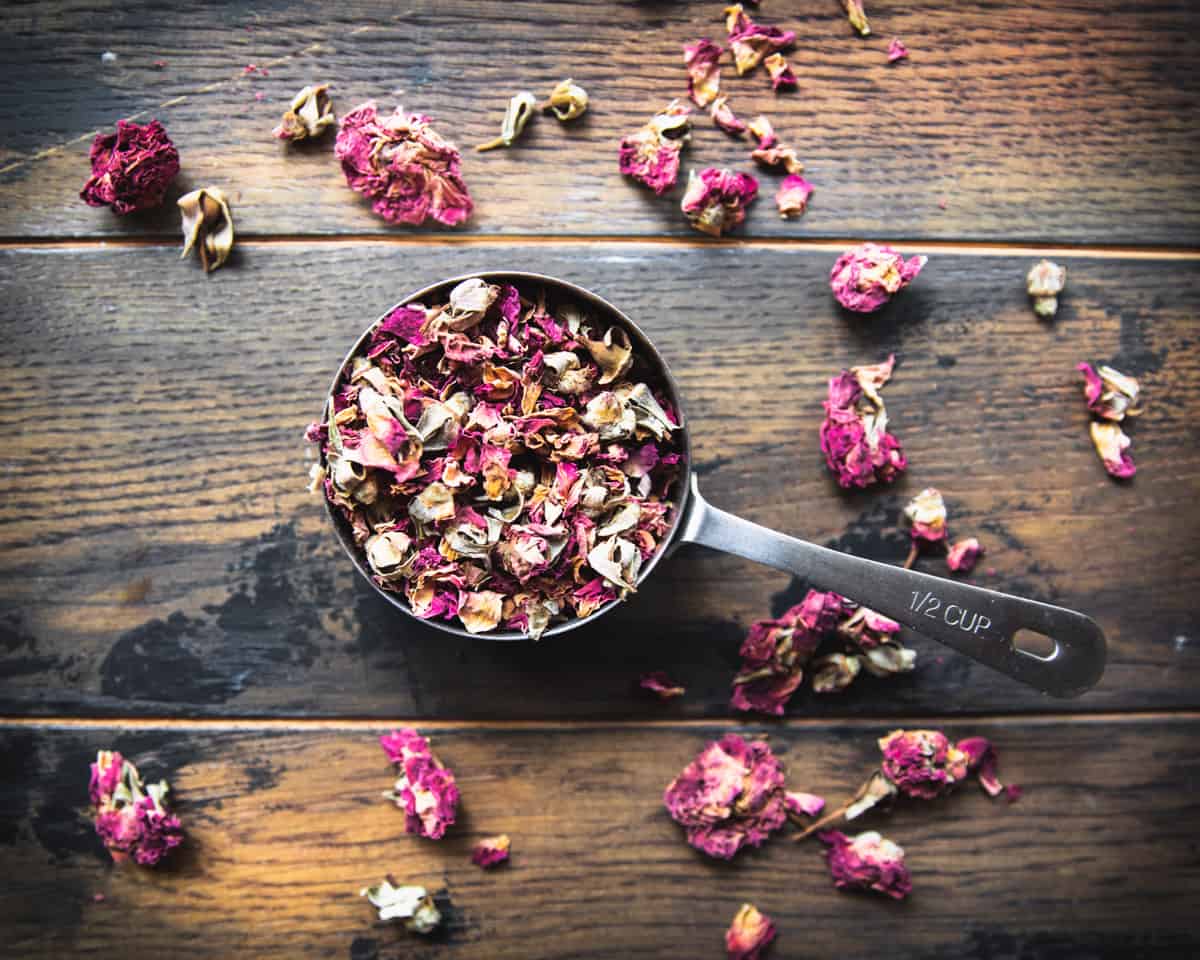
Alkanet root is part of the borage family, and it has beautiful flowers. In this instance though, we are using the root for its lovely natural bright red color! It will make your oil infusion red, which will become pink as the rest of the ingredients are added.
The alkanet root is optional, so if you don’t want pink lotion bars, feel free to omit the root from the oil infusion step.
Sweet almond oil is popular to use as a carrier oil in DIY body care recipes, it has vitamins A and C, and soaks into the skin wonderfully. If there is another carrier oil you love, substitute it with what works best for you.
Lotion Bars
Beeswax is hydrating and gives natural moisture to the skin, helps relieve itching, and moisturizes dry skin.
Roasted cocoa butter gives a divine chocolatey smell and a super creamy texture to this lotion bar recipe. For a less chocolatey smell, opt for unroasted cocoa butter.
Geranium essential oil and/or rose absolute oil give these lotion bars an uplevel in floral scent, which is lovely for those who want a stronger smell. If you like a light rose scent, the infused oil will do just fine!
I used these heart molds and these flower molds to shape each lotion bar. For a more basic shape, try these round molds.
You could also improvise by pouring it into something you already have or can make at home (like a wooden soap mold, for example) and then cutting it into bars once it has solidified.
Rose Lotion Bars Recipe
Make the Infused Oil
The first step is to make an infused oil with dried rose petals and the alkanet root for the color. There are many methods for doing this, see my post on how to make infused herbal oils for more information.
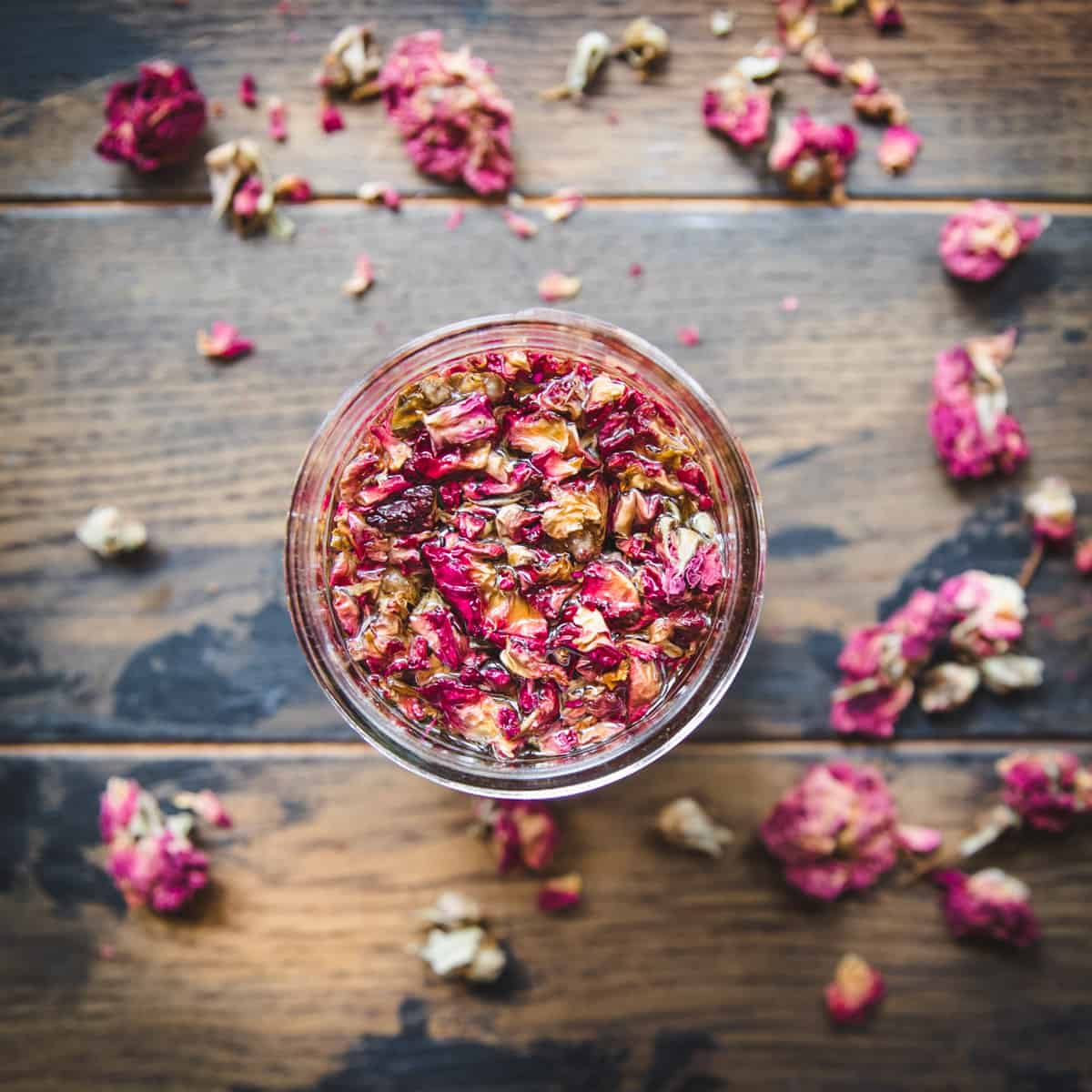
Add the dried rose petals and alkanet root to the jar, and cover it with sweet almond oil. Cover the jar with a lid and tuck it into a cool place out of direct sunlight to infuse for at least one week, and up to six weeks.
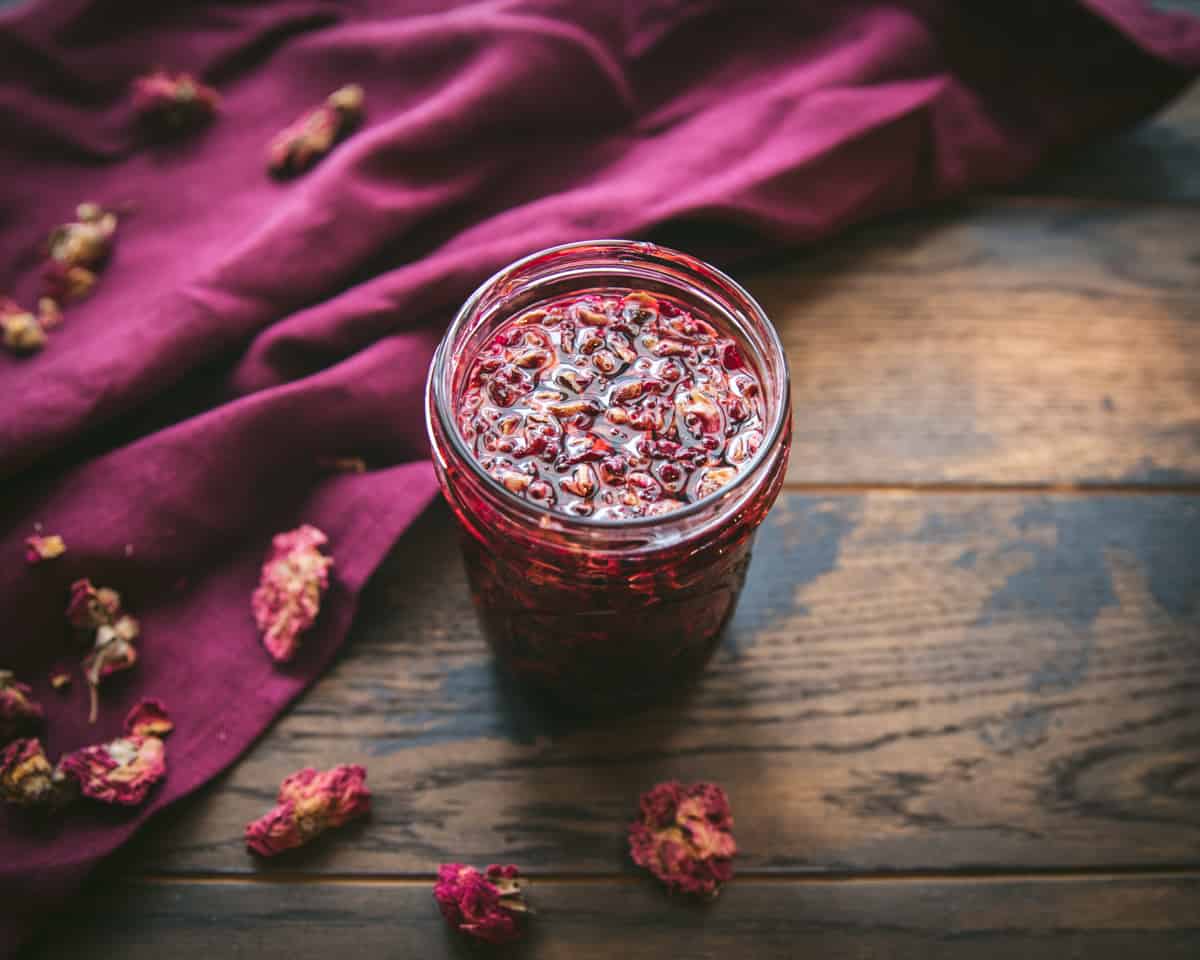
Once the oil is fully infused and a beautiful red color, strain out the rose petals and alkanet root using a fine mesh sieve.
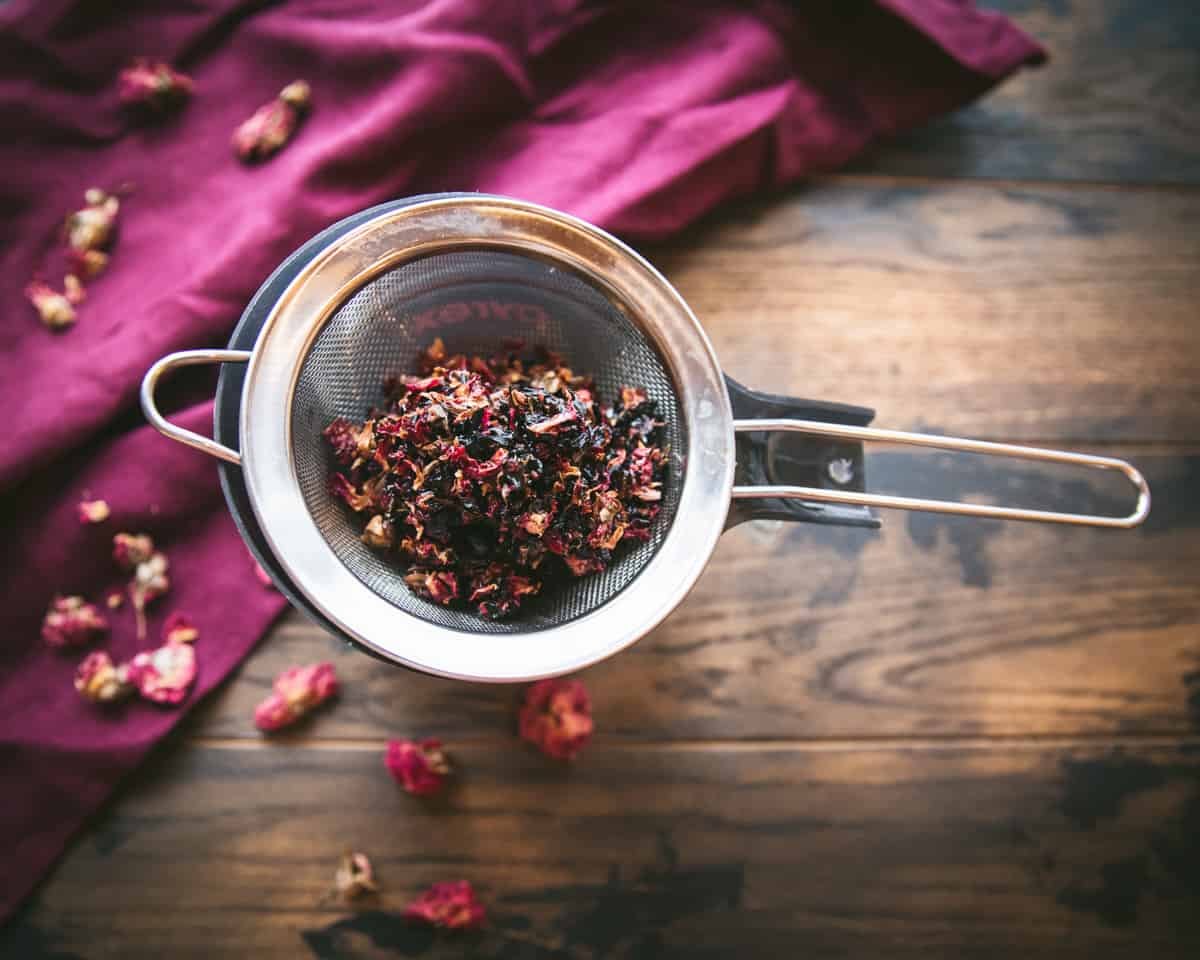
Reserve 1/2 cup of the infused oil to make the lotion bars. Any extra oil can be saved to use topically.
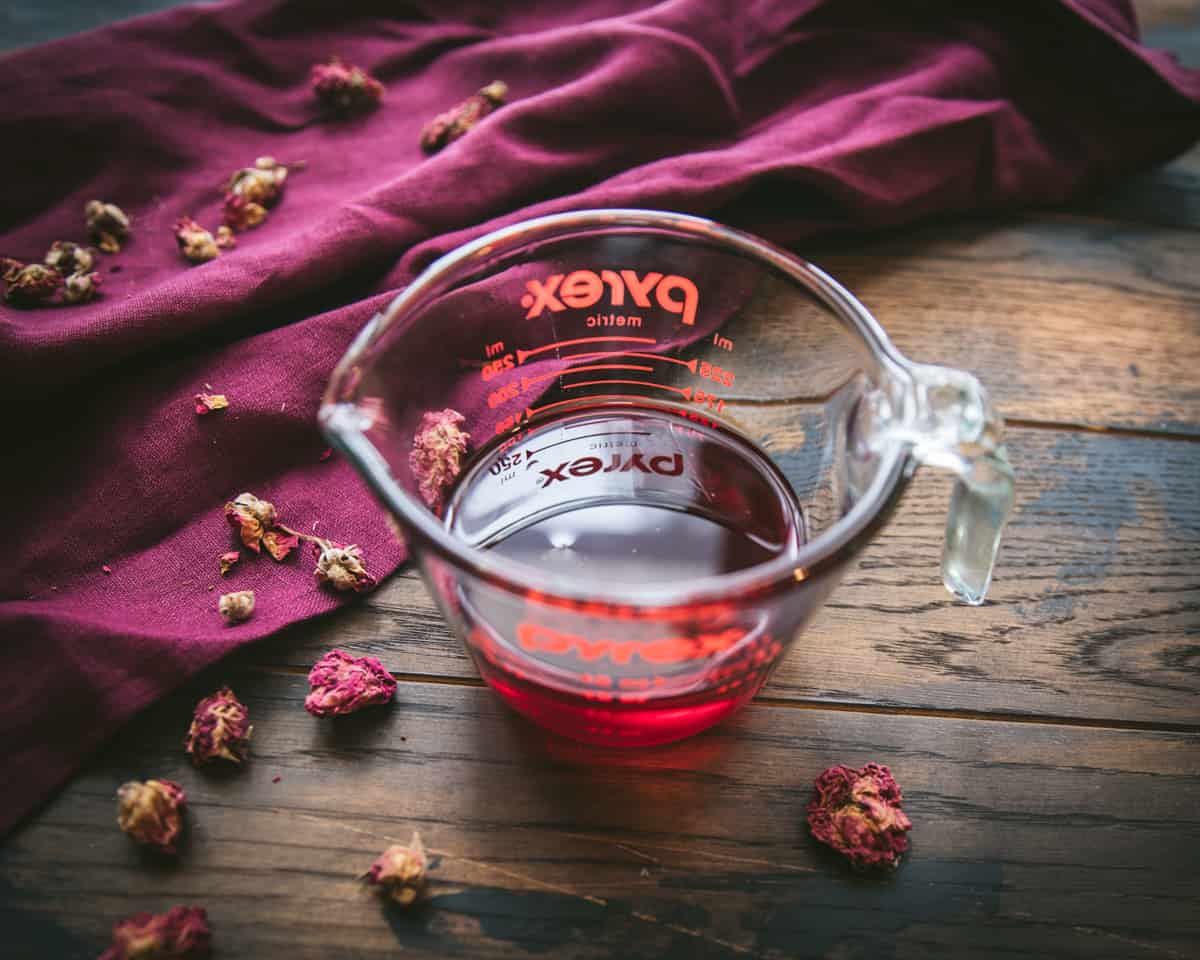
Make the Lotion Bars
Use a double boiler, or make one yourself by using a stainless steel bowl or a glass measuring cup in a pot with about an inch of water in it.
Bring the water to a simmer and gently heat the oil and beeswax in the double boiler until the beeswax has dissolved. If you are using beeswax bars instead of pastilles, cut them into smaller chunks and let them start to melt first.
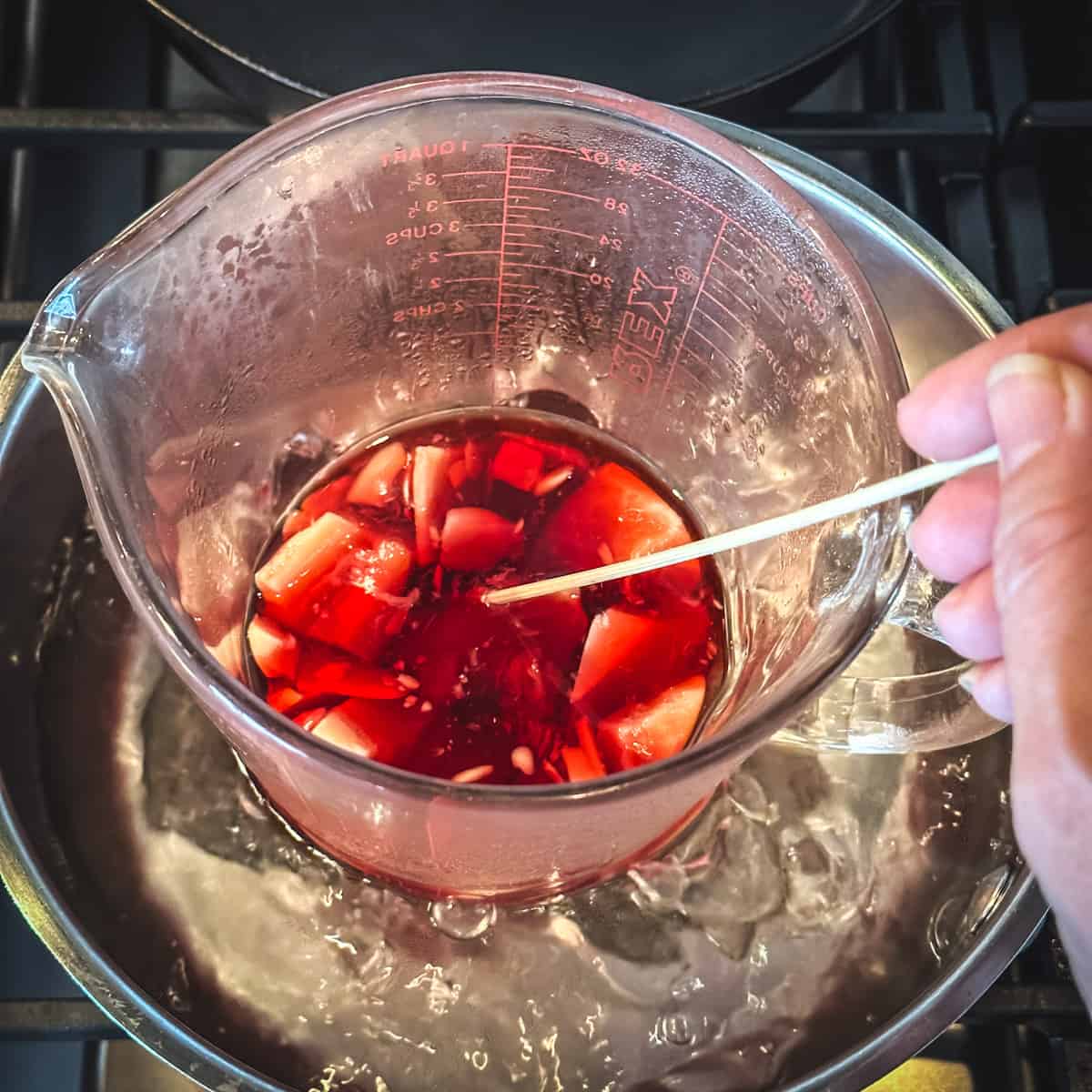
Then add the cocoa butter and let it dissolve completely. A wooden or bamboo skewer works well to stir the mixture.
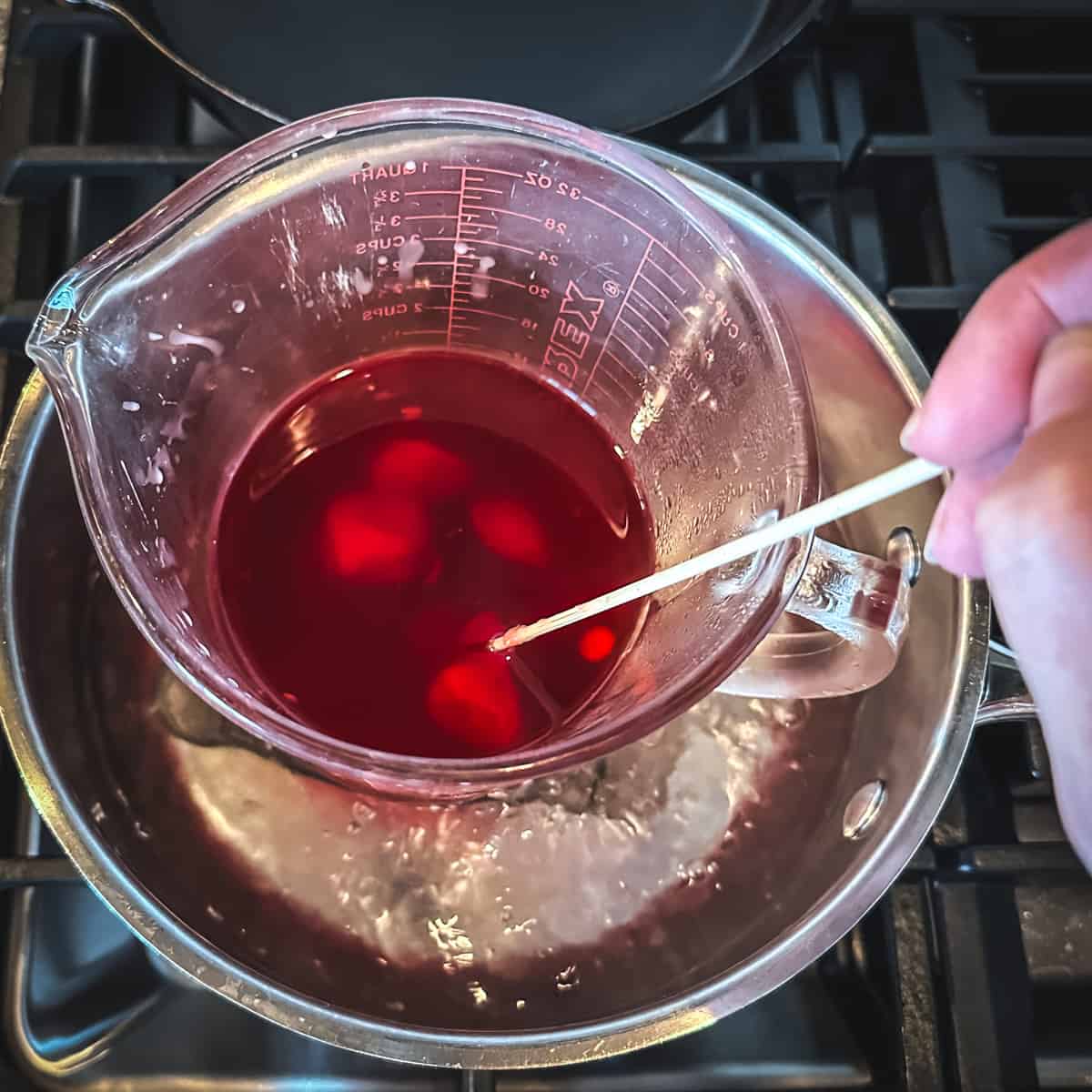
Once everything has completely dissolved, let it cool for a minute or two before stirring in the optional essential oil.
Then carefully pour the mixture into the molds, and wait a few hours for them to completely harden.
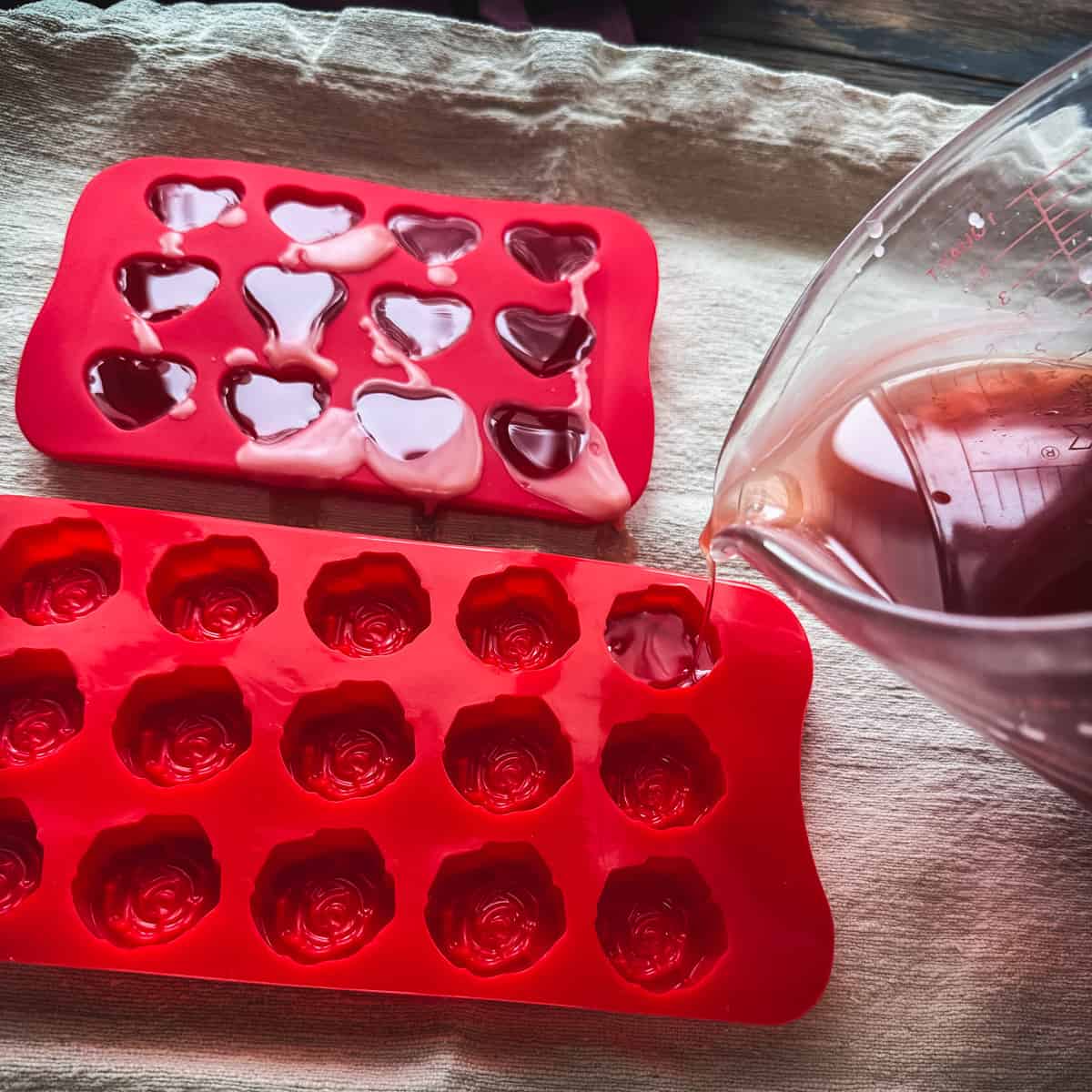
Once dry and hardened, gently pop each lotion bar out of the molds!
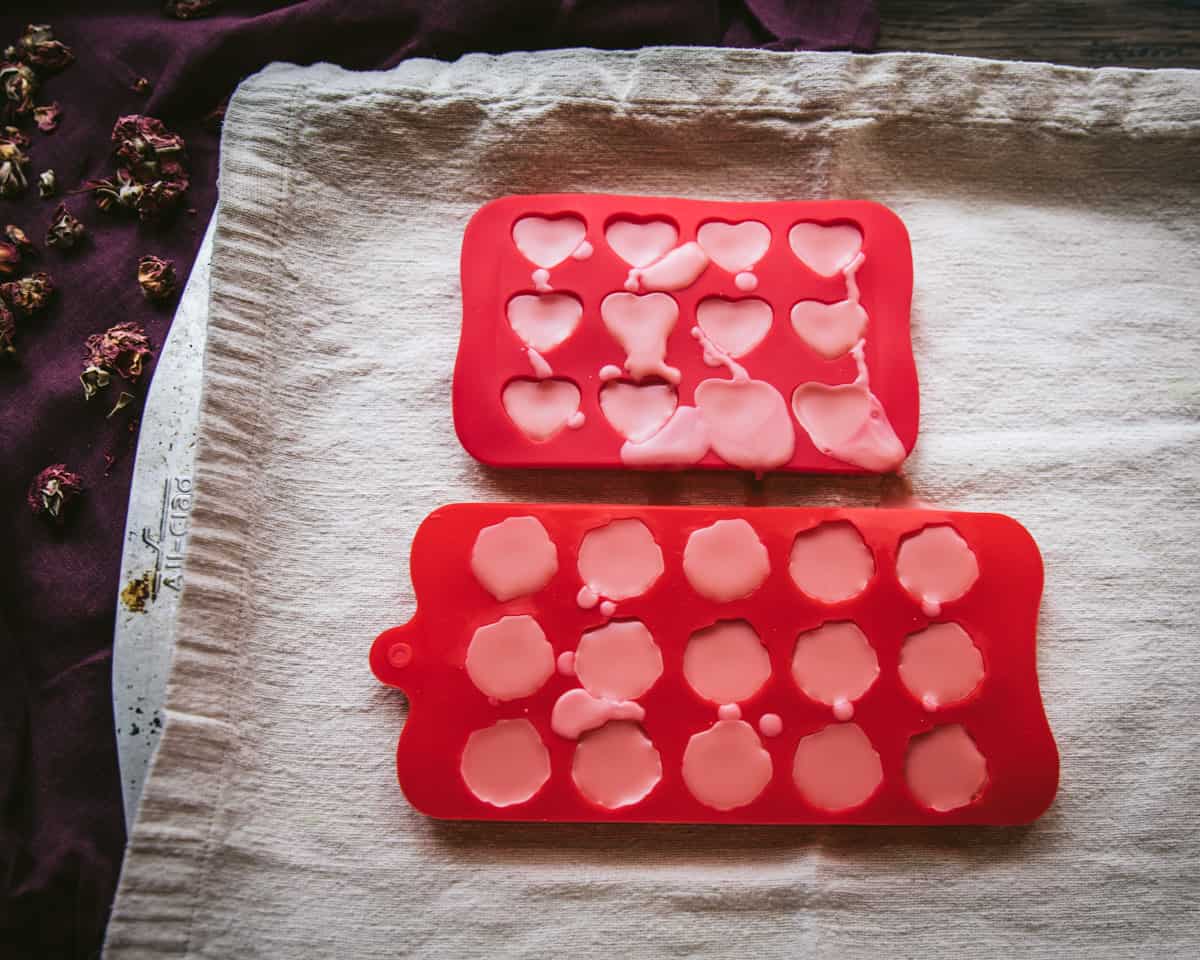
They popped right out of the mold very easily! I am really pleased with how these lotion bars turned out, and they were incredibly simple to make.
Depending on the size of your mold, you will get anywhere from 12-24 lotion bars with this recipe. The mini molds like I used here will make 24 or more mini lotion bars!
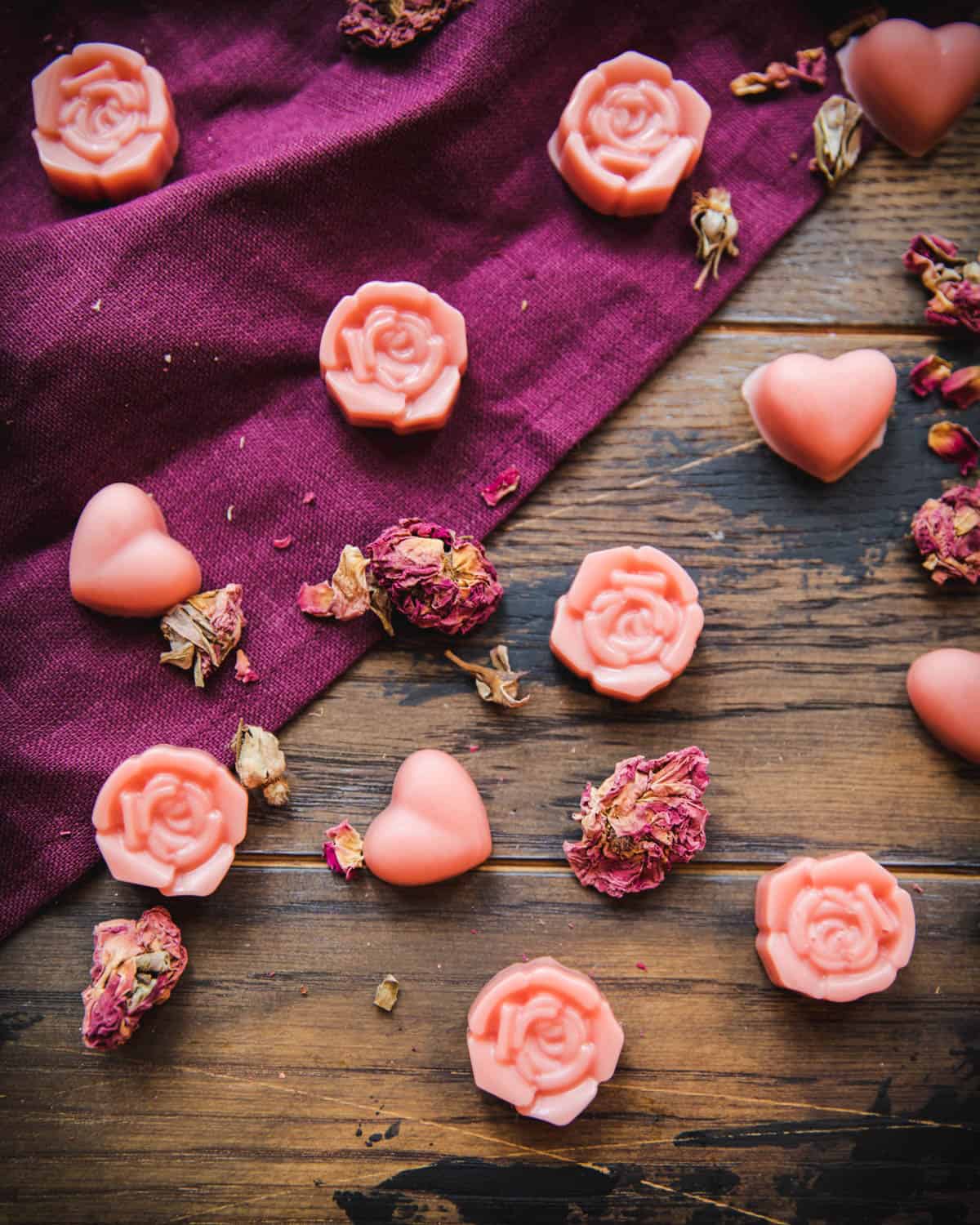
How Long is a Lotion Bar Good For?
These lotion bars should be stored in tins or any small container that works for you. They are great for packing, traveling, and carrying in your bag.
You’ll have soft lovely smelling skin wherever you go, bringing these skin-calming and moisturizing bars with you!
Lotion bars won’t go bad, they’ll store and work until they’re gone.
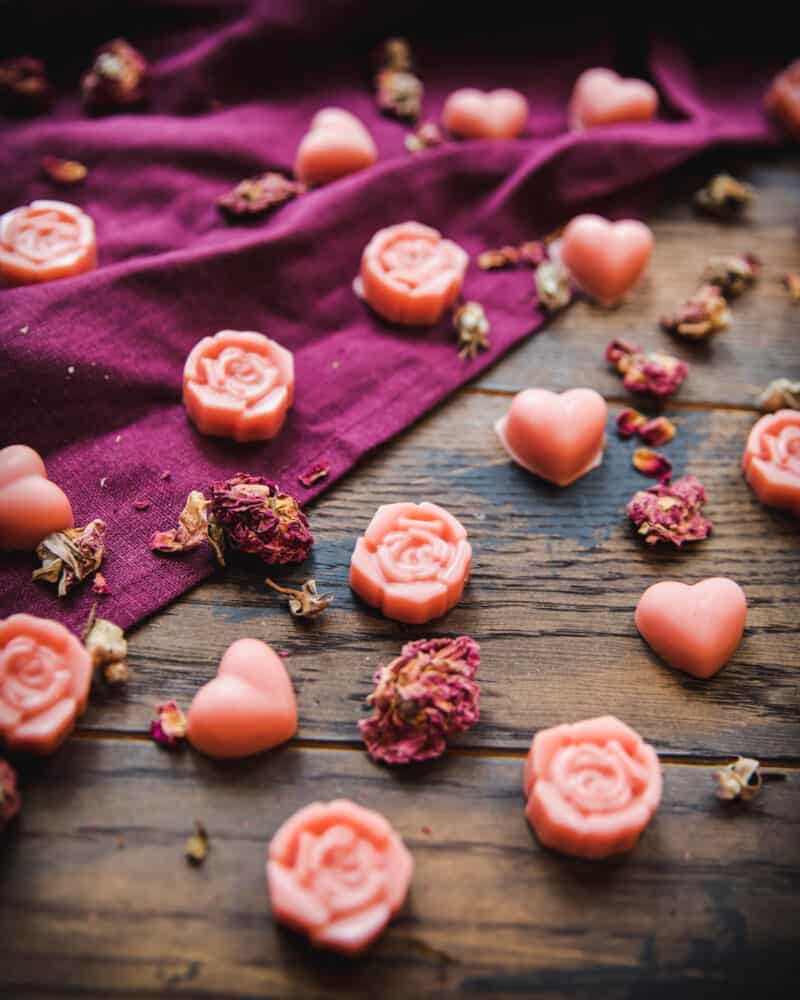
How to Use Rose Lotion Bars
These little beauties are not only great for passing out instead of Valentine’s candies, but you can and should save some for yourself.
Be your own Valentine this year, and give your skin some soothing self-love.
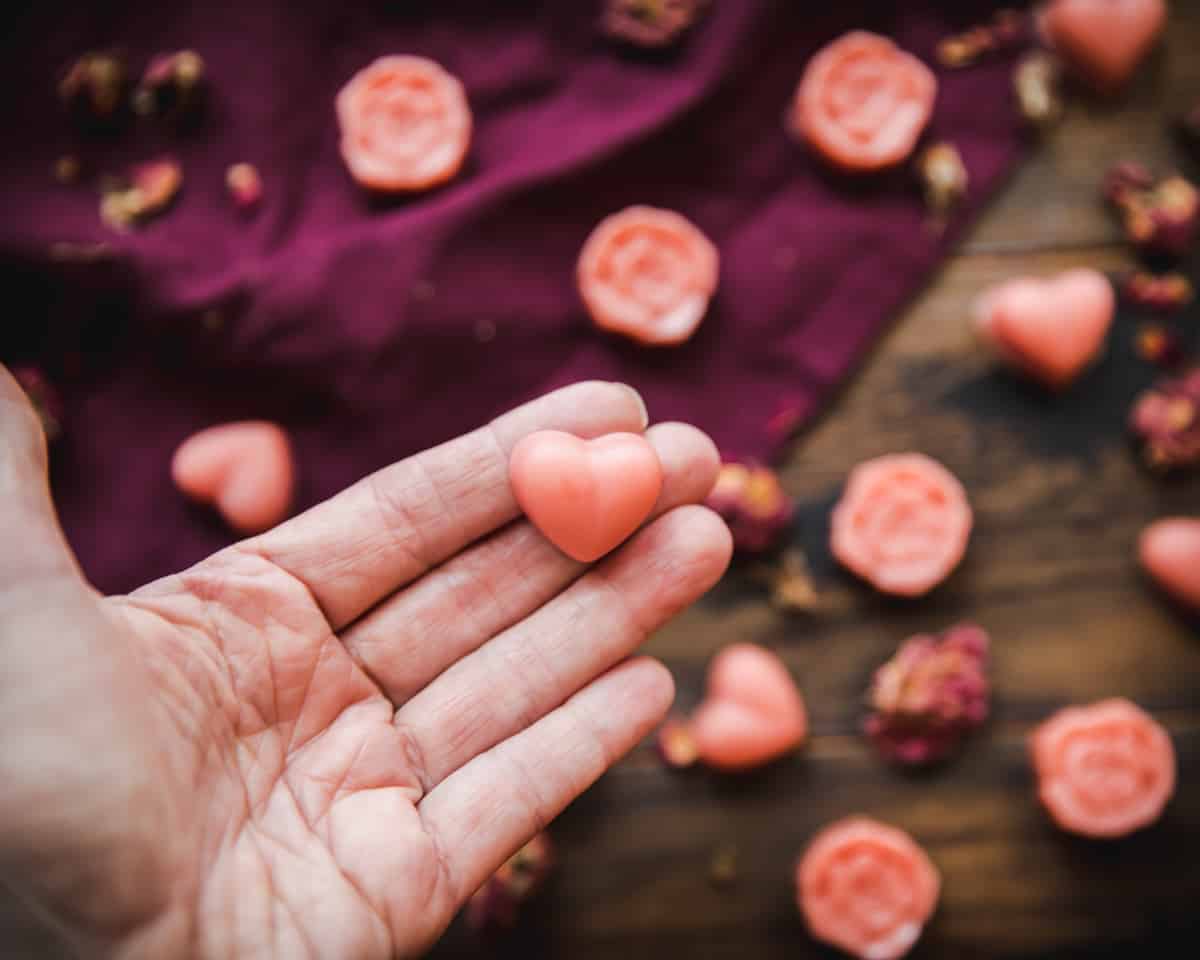
These can be rubbed on dry skin anywhere you need a moisture boost. Perfect for hands, feet, or anywhere else your skin needs some calming love.
A great way to use these is right out of the shower or bath, with warm skin they melt on and soak right into your skin for maximum softness, comfort, and a super lovely smell!
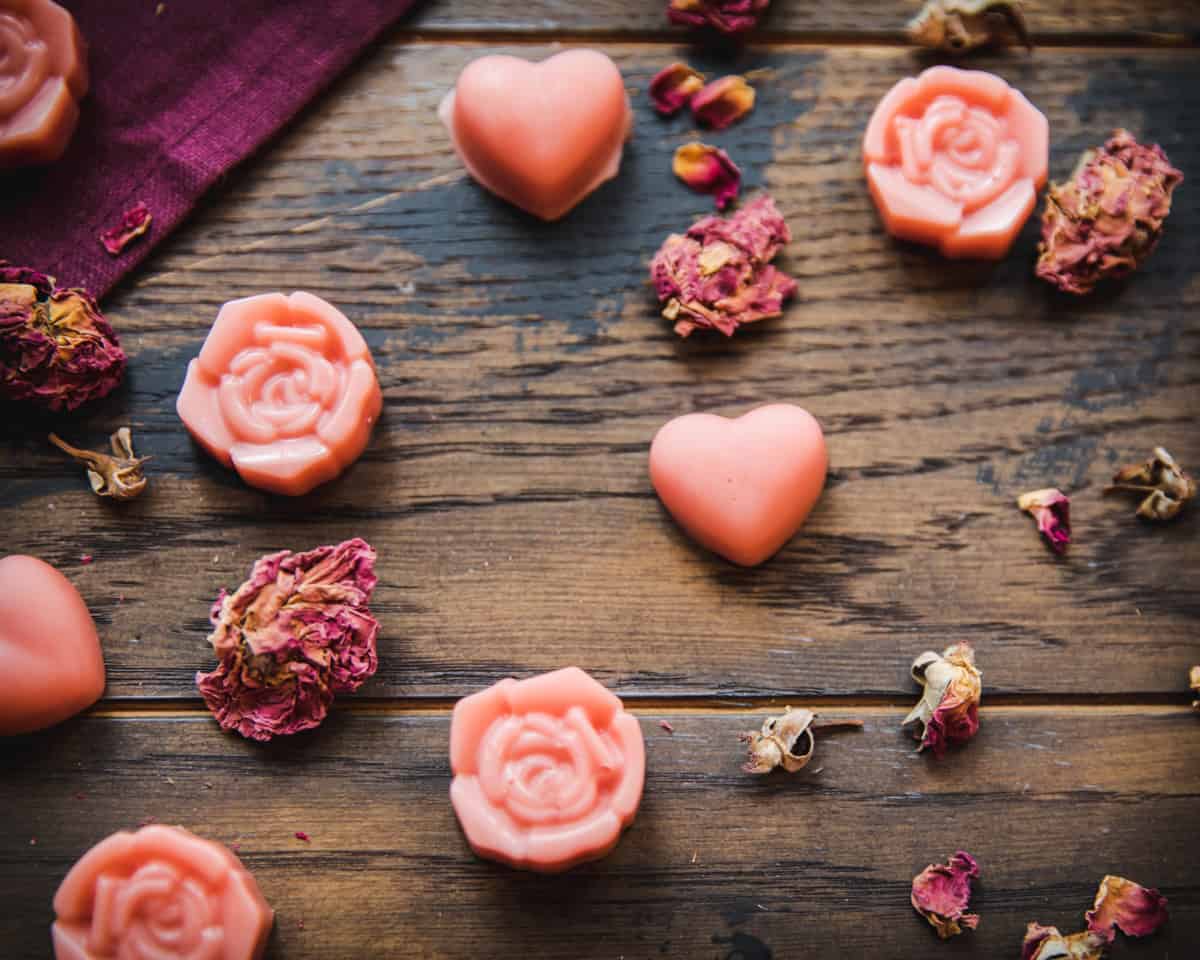
More DIY Rose & Rosehip Skin Care Recipes
- Rosehip Facial Serum
- Homemade Rose Hip Soap
- Wild Rose & Yarrow Soap
- Rose Hip Lip Balm
- 60+ Rosehip Recipes
Rose Lotion Bars
Equipment
Ingredients
Rose Infused Oil
- ½ cup dried rose petals or buds
- 1 Tbsp alkanet root (optional but recommended for color)
- 1 cup sweet almond oil
Rose Lotion Bars
- ½ cup rose infused oil
- 3 oz beeswax
- 4 oz cocoa butter
- 4-5 drops geranium essential oil or rose absolute oil (optional)
Instructions
Rose Infused Oil
- Place the rose petals and alkanet root in a half pint jar and cover completely with sweet almond oil.
- Cover the jar with a lid and place in a cool place out of direct sunlight for at least a week and up to 6 weeks.
- Once the oil is fully infused and you are ready to make the lotion bars, strain out the rose petals and alkanet root, reserving the infused oil.
Rose Lotion Bars
- Create a makeshift double boiler by putting a smaller pan, bowl, or glass measuring cup in a larger pan that has an inch or two of water in it, and bring the water to a simmer
- Measure out ½ cup (120ml) of the rose infused oil (save any excess oil you may have to use topically).
- Put the oil into the double boiler. Add the beeswax to the oil and continue to heat until it has completely melted. A wooden skewer works well as a stirrer.
- Stir in the cocoa butter until everything is fully liquefied, then remove the mixture from the heat.
- Quickly stir in the essential oil, if using.
- Quickly and carefully pour the mixture into the lotion bar molds.
- Let the lotion bars sit undisturbed until they solidify completely. This will take several hours. Then pop them out of the mold and store in tins or other containers.

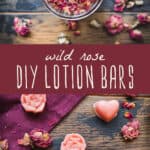
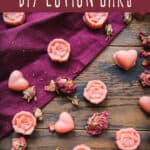


Hi! Thanks for sharing this great recipe. I don’t have a scale, so about how much in cups would the 3oz beeswax and 4oz cocoa butter be?
I’m not sure exactly. I would guess a few table spoons or a 1/4 cup?
Could you please tell me where can I buy the rose moulds. I live in Australia. Thank you.
There’s a link to the mold under the “equipment” section of the recipe.
I will have to purchase the rose petals. About how many ounces will I need for the 1/2 cup? Thank you.
I’m really not sure, sorry.
Thanks for the wonderful recipe. I have never used rose petal macerate. It will come in handy for dry skin on my elbows. Nenad – Croatia.
You’re welcome!!
Hi.
I regularly make WildRose Jelly or jam and also make regular Rose Jelly or Jam when my neighbors with rose bushes will share. So yummy and pretty as well.
Sounds Lovely
Hi,
i have tried this reciepe several times, but everytime in pour in the essential oil it evaporates and once cooled out it smells only of wax. I even tried with other essential oils and i try to pour in the essential oil in last moment before wax starts hardening, bit even then it has a temperature of around 60 °C and i heard that the essential oil should not be used beyong 40°C.
Please help!
Thank you so much for your answer.
These are amazing!!! If you like rose you will love these! Thank you so much! :)
This will be my first fresh rose petals so do I let them air dry out bake them dry or just pick them off the stem and put them in carrier oil
It’s better to dry them first as fresh petals could cause the oil to go rancid faster.
Hi Colleen, thank you for posting this recipe. I would like to know if any type of rose petal can be used, whether it’s from a knockout rose bush or wild rose bush? By the way, I want to let you know I’m really enjoying your book Healing Herbal Infusions. Gathering from plants outside is something my 3 year old son and I really enjoy doing together. Being able to use what we have picked and make something out of it is quality time I cherish. Except when he is on the baseball field picking dandelions instead of chasing after the baseball lol.
Hi Faith, any and all types of rose petals can be used! And I’m so glad to hear that you are enjoying my book!
how many bars does it make
Depending on the mold 3. I did not fill mine all the way through.
When making the infused oil, what quantity of oil do you need?
Hello and thank you for sharing this yummy lotion recipe. What is the oil you infused the rose petals in?
I appreciate your comment about shea butter becoming grainy when overheated! Since it’s quite grainy to begin with it took me a few tries to figure out to add it last. ☺
HI! I’m about to make these as Christmas gifts. I have my infused oil (made from roses from my 40th birthday) and all of the other ingredients, but I am not certain about your recipe. It looks like you use a 1/4 cup of the three items, but then there are different gram amounts – could you expand on this? I know 1 ounce equals 28 grams (the amount you show for the beeswax…..). Any help would be very appreciated!! Many thanks!
Actually I figured it out online – I forget that solids and liquids are measured differently ;-)
Thank you for sharing but what about lye?
It’s not soap, it’s a lotion bar so no lye is necessary.
These look great!! I’m going to make a large quantity for a bridal shower. Since I only have 2 molds to make 12 at a time, can I put them in the freezer to speed up the drying time or will that damage them? I thought I would ask so I can try and do them all in one shot.
Thanks!
-Jessica
I think that will probably work just fine… I’ve never done it myself so I can’t say for sure, but I don’t see why it would be a problem!
I always put mine in the freezer to speed the hardening process. I am much to impatient to wait. LOL
I made rose water and then used it in making facial toner with organic witch hazel , chamomile , lavender and tea tree oil! Awesome for after moisturizing and as a mineral makeup setter .
Erica,
How did you make the rose water? And what were your proportions for creating the facial toner. It sounds amazing, and I’d love to try it if you don’t mind sharing?!
Thank you !
Shari
Hi Colleen, here a small question from the other side of the globe (West of Europe)…
This recipe sounds and looks great ánd easy, but I’m not familiar with the use of lotion bars in general… Do you use them as a soap or as a stick (like lip balm sticks) or do you melt them before use??
Hi Nicky, that’s a good question. No, they are not a soap and you don’t want to melt them before use. They are more of a stick like you say. Just rub them on any areas where you have dry skin!
I haven’t made lotion bars in awhile! I’m inspired! Your bars are beautiful!
Thank you!
I haven’t made anything with roses yet (although I have used rose water and syrup in cooking), but it’s on my to do list. Thanks for sharing, these look lovely :)
Beautiful!